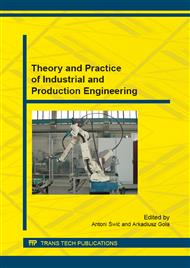[1]
Y. Kwon, G.W. Fischer, A novel approach to quantifying tool wear and tool life measurements for optimal tool management, International Journal of Machine Tools and Manufacture, 43 (2003) 359–368.
DOI: 10.1016/s0890-6955(02)00271-7
Google Scholar
[2]
F. Cus, M. Milfelner, J. Balic, An intelligent system for monitoring and optimization of ball – end milling process. Journal of Materials Processing Technology, 175 (2006) 90–97.
DOI: 10.1016/j.jmatprotec.2005.04.041
Google Scholar
[3]
H. Shao, H.L. Wang, X.M. Zhao, A cutting power model for tool wear monitoring in milling. International Journal of Machine Tools & Manufacture, 44 (2004) 1503–1509.
DOI: 10.1016/j.ijmachtools.2004.05.003
Google Scholar
[4]
M. Wiercigroch, E. Budak, Sources of nonlinearities, chatter generation and suppression in metal cutting, Philosophical Transactions of the Royal Society of London, 359 A (2001) 663–693.
DOI: 10.1098/rsta.2000.0750
Google Scholar
[5]
T.P. Zieliński, Cyfrowe przetwarzanie sygnałów – od teorii do zastosowań, WKŁ, Warszawa (2005).
Google Scholar
[6]
P. Wittbrodt, Algorytmy samouczące w zastosowaniu do technologicznych systemów prognozujących proces obróbki frezowaniem, XI Międzynarodowa Konferencja Naukowo-Techniczna, Technologiczne Systemy Informacyjne w Inżynierii Produkcji i Kształceniu Technicznym, Kazimierz Dolny nad Wisłą, (2013).
Google Scholar
[7]
P. Wittbrodt, Life and Wear of Monolithic Carbide Mills, Maintenance And Reliability, 3 (2005).
Google Scholar
[8]
P. Wittbrodt, A. Paszek, Decision support system of machining process based on the elements of fuzzy logic, ModTech International Conference, Modern Technologies in Industrial Engineering, Mamaia, Romania, 2015 (in print).
Google Scholar
[9]
T. Matsumura, E. Usui, Self – adaptive tool wear monitoring system in milling process, Transactions of NAMRI/SME 29, (2001).
Google Scholar


